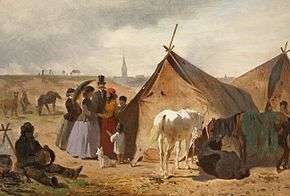Romani people in Germany
| |||
| Total population | |||
|---|---|---|---|
| (170,000-300,000) | |||
| Languages | |||
| Sinte Romani, German | |||
| Religion | |||
| Christianity, Romani religion | |||
Romani people in Germany are estimated to around 170,000-300,000, constituting around 0.1% of the population. One-third of Germany Romani belong to the Sinti group. The majority of Romani in Germany lack German citizenship, having immigrated mostly from Hungary, Slovakia, Czech Republic, Romania, Albania, and Kosovo, and the other countries of former Yugoslavia.[1] Most speak German or Sinte Romani.
History
Origin
The Romani people originate from the Northern India,[2][3][4][5][6][7] presumably from the northwestern Indian states Rajasthan[6][7] and Punjab.[6]
The linguistic evidence has indisputably shown that roots of Romani language lie in India: the language has grammatical characteristics of Indian languages and shares with them a big part of the basic lexicon, for example, body parts or daily routines.[8]
More exactly, Romani shares the basic lexicon with Hindi and Punjabi. It shares many phonetic features with Marwari, while its grammar is closest to Bengali.[9]
Genetic findings in 2012 suggest the Romani originated in northwestern India and migrated as a group.[3][4][10] According to a genetic study in 2012, the ancestors of present scheduled tribes and scheduled caste populations of northern India, traditionally referred to collectively as the Ḍoma, are the likely ancestral populations of modern European Roma.[11]
In February 2016, during the International Roma Conference, the Indian Minister of External Affairs stated that the people of the Roma community were children of India. The conference ended with a recommendation to the Government of India to recognize the Roma community spread across 30 countries as a part of the Indian diaspora.[12]
Migration to Germany



The Sinti arrived in Germany and Austria in the Late Middle Ages.[13]
See also
- Central Council of German Sinti and Roma
- Documentation and Cultural Centre of German Sinti and Roma
- Ethnic groups in Germany
References
- ↑ "World Directory of Minorities and Indigenous Peoples - Austria : Roma/Gypsies". United Nations Human Rights Council. Retrieved 2012-08-26.
- ↑ Hancock 2002, p. xx: ‘While a nine century removal from India has diluted Indian biological connection to the extent that for some Romanian groups, it may be hardly representative today, Sarren (1976:72) concluded that we still remain together, genetically, Asian rather than European’
- 1 2 Mendizabal, Isabel (6 December 2012). "Reconstructing the Population History of European Romani from Genome-wide Data". Current Biology. Retrieved 12 December 2012.
- 1 2 Sindya N. Bhanoo (11 December 2012). "Genomic Study Traces Roma to Northern India". New York Times.
- ↑ Current Biology.
- 1 2 3 "Flamenco on the Global Stage: Historical, Critical and Theoretical Perspectives - K. Meira Goldberg, Ninotchka Devorah Bennahum, Michelle Heffner Hayes - Google Books". Books.google.ca. Retrieved 2016-05-21.
- 1 2 Simon Broughton; Mark Ellingham; Richard Trillo. "World Music: Africa, Europe and the Middle East". Books.google.ca. p. 147. Retrieved 2016-05-21.
- ↑ Šebková, Hana; Žlnayová, Edita (1998), Nástin mluvnice slovenské romštiny (pro pedagogické účely) (PDF), Ústí nad Labem: Pedagogická fakulta Univerzity J. E. Purkyně v Ústí nad Labem, p. 4, ISBN 80-7044-205-0
- ↑ Hübschmannová, Milena (1995). "Romaňi čhib – romština: Několik základních informací o romském jazyku". Bulletin Muzea romské kultury. Brno: Muzeum romské kultury (4/1995).
Zatímco romská lexika je bližší hindštině, marvárštině, pandžábštině atd., v gramatické sféře nacházíme mnoho shod s východoindickým jazykem, s bengálštinou.
- ↑ "5 Intriguing Facts About the Roma". Live Science.
- ↑ Rai, N; Chaubey, G; Tamang, R; Pathak, AK; Singh, VK (2012), "The Phylogeography of Y-Chromosome Haplogroup H1a1a-M82 Reveals the Likely Indian Origin of the European Romani Populations", PLoS ONE, 7 (11): e48477, doi:10.1371/journal.pone.0048477
- ↑ "Can Romas be part of Indian diaspora?". khaleejtimes.com. 29 February 2016. Retrieved 4 March 2016.
- ↑ "Performance in Gypsy Autobiographies from Austria and Germany". Dickinson College. Retrieved 2013-10-20.
External links
- Romani Rose Giving Germany's Sinti and Roma a Face
- Roma and Sinti in Germany
- Sinti, Roma and Racism: Report Blasts Berlin's Inaction
- Germany: TV discussion Sinti and Roma a concept of enemy: are we too intolerant?


